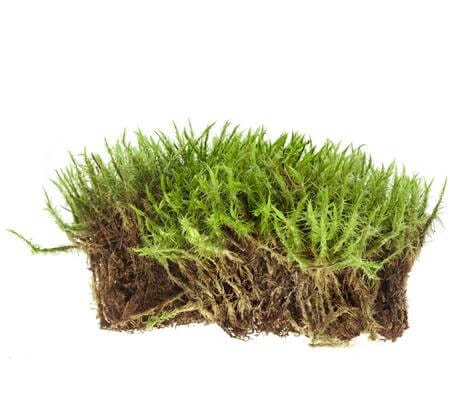NAME: Moss
Latin name: Bryophyta
The number one problem for most lawns in northern Ireland is moss. It’s the question people ask us the most at Premier Lawns and how to get rid of it.
The problems relating to moss are often caused by;
- Cool shady conditions
- Scalping the grass or not frequent enough mowing
- Excessive thatch
- Turf compaction
- Not enough nutrients in the soil
- Cutting the grass too short.
- Turf with poor density is susceptible to moss infestation.

Premier Lawns recommends a strategy to create an environment, which is not suitable for the growth of moss.
If the lawn has shady conditions it may be required to cut back some branches on trees and shrubs to allow more light onto the lawn.
Regular mowing at the proper height, is one of the easiest ways to improve a lawn. Many people wrongly believe a lawn should be cut very short, this often harms the lawn unless you are using a specialist mower such as a cylinder mower commonly used on golf and bowling green’s you will be damaging the grass plant – making it weaker and allowing the moss establish in the lawn
We will be happy to help you set your mower to the required height and advice on how often it should be cut.
Thatch
Thatch is an organic layer below the green leaf material of the lawn and above the soil itself. It consists of dead, dying and living stems, roots and leaves, in fact, all parts of the grass plant. A thick thatch layer will have a number of detrimental effects on any lawn. The surface will feel spongy and can stay wet for longer. It prevents the infiltration of water and therefore affects the drainage properties of the lawn.
Excess that occurs when the new tissue develops at a rate quicker than soil microbes can break it down.
Thatch also acts as a harbour for pests and diseases to develop and feed in. It promotes the ideal conditions for weed invasion, mosses and undesirable grass species. Thatch can also trap within it any nutrients applied to a lawn resulting in a very shallow root system. Shallow rooted grasses offers poor drought resistance, colour and density and the plants ability to recover from wear will be drastically reduced.
Premier Lawns use a soil sample to lawn at the soil profile that pulls out a plug that allows us to see the soil profile.
Moss
Moss is often a sign of unhealthy, compacted lawns with an excessive thatch layer. After we have done all the cultural things to improve the lawn (Allowing more light at the lawn, proper heights of cut and more frequent mowing) it is time for the mechanical treatments.
Aeration – In simplest terms, it is the process of making finger sized holes in your lawn and depositing the removed material on the surface to break down. This allows fertiliser, water and oxygen to get to the roots where healthy grass originates.
Scarifying – Your lawn loves getting scarified, it opens the grass sward up allowing water and nutrients to pass through, it cuts out the excessive thatch later where the moss grows and also pulls out the moss too.
Regular lawn feeding – It’s a fact that lawns benefit from regular feeding. Without extra nutrients grass soon uses up plant food reserves in the soil and then turns pale and thin. Without food to develop side shoots and thickness, the lawn is open to invasion by weed seeds and moss that thrive in low nutrient conditions.
